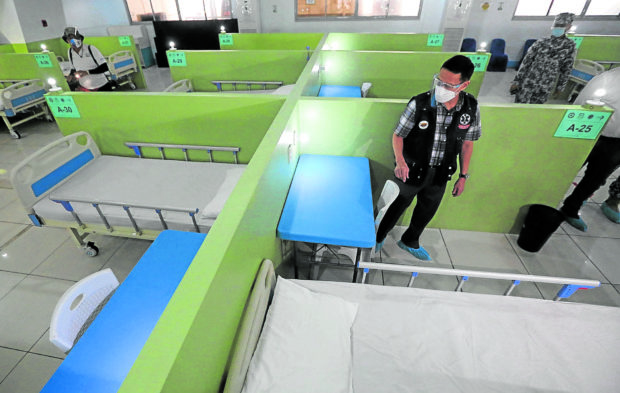Too early to lift quarantine restrictions in ‘NCR Plus’ – DOH

PORT ISOLATION Health Secretary Francisco Duque III on Monday inspects a 45-bed COVID-19 isolation center set up at Eva Macapagal Terminal in Port Area, Manila, as hospitals in Metro Manila hit full capacity. —MARIANNE BERMUDEZ
MANILA, Philippines — The Department of Health (DOH) and a medical doctors’ group are calling for an extension by at least two more weeks of the modified enhanced community quarantine (MECQ) in Metro Manila and nearby Cavite, Laguna, Rizal, and Bulacan provinces as hospitals are still crowded with COVID-19 patients.
“If we look at the data, I firmly believe that we should extend the MECQ for another week or two since our health system capacity has not yet improved much as of now,” Health Secretary Francisco Duque III said on Monday.
President Rodrigo Duterte has placed the National Capital Region (NCR) and the four provinces, dubbed “NCR Plus” bubble, under the less stringent MECQ up to April 30 to ease the impact of the pandemic on the economy, lifting the two-week enhanced community quarantine (ECQ) despite the surge in coronavirus cases that filled up hospitals.
“Let us continue the MECQ so we can see a bigger decrease in cases and possibly reverse the trend [of swelling cases] completely,” Duque said.
The Metropolitan Manila Development Authority (MMDA) on Monday said the current pandemic situation in the region was still “fragile and unstable” even as health experts were unsure whether the downtrend in the number of cases would continue long enough to improve the economy.
Article continues after this advertisementGrowth, attack rates
Metro Manila mayors have yet to finalize their recommendation on the capital region’s quarantine status for the next two weeks, MMDA chief Benhur Abalos said in a television interview. They were still waiting for reports from the country’s economic managers as a consideration to laborers hoping to get back to work, he said.
Article continues after this advertisementOn Sunday, the MMDA reported that the two-week COVID-19 case growth rate in Metro Manila was at minus-5 percent compared with 164 percent from March 14 to 27. Abalos attributed this improvement to the ECQ and MECQ implemented in NCR and four nearby provinces, and urged residents to strictly follow minimum health standards so that efforts to reduce the number of cases would not be “put to waste.”
According to Health Undersecretary Maria Rosario Vergeire, Metro Manila last week averaged 9,500 daily detected cases, down from 10,800 the previous week. She was quick to add, however, that its daily attack rate was still high at 19 to 55 detected cases for every 100,000 population.
The Philippine College of Physicians (PCP) said the overwhelmed hospitals and other health-care facilities in Metro Manila and surrounding provinces had not yet felt the intended effect of the ECQ since March 29 and the MECQ since April 12.
“These (community restrictions) did not make a dent as far as the number of people [going to] hospitals. It is still too early to lift the restrictions that we have right now,” PCP Vice President Dr. Maricar Limpin said.
Vergeire stressed that hospitals that had been overrun with COVID-19 patients since March should be decongested.
3 scenarios
Experts advising the DOH, she said, were studying three scenarios—MECQ until May 15 or until May 31, and the lifting of MECQ as scheduled by May 1.
“We see the importance of continuing the restrictions so we can provide respite and decongest our health system which is our major concern,” Vergeire said in the daily press briefing on Monday. “If we lift the restrictions, we know cases will increase and if we continue these restrictions, we can stabilize the (number of new) cases,” she said.
In a press briefing, Duque said the government was now focused on opening more ICU (intensive care unit) beds as what doctors needed to treat severe cases and prevent deaths.
He said the ICU utilization rate in Metro Manila was 86 percent, putting it at a critical risk level, while that of temporary treatment and monitoring facilities or quarantine hubs was at 72 percent.
Generally, 65 percent of hospital ward beds, ICU and mechanical ventilators are currently in use in Metro Manila and nearby provinces.
An epidemiologist on Monday said he would not recommend the return of Metro Manila to general community quarantine (GCQ) category next month until local governments could show improvements in their strategies against the pandemic.
Dr. John Wong, an adviser of the Inter-Agency Task Force for the Management of Emerging Infectious Diseases and member of its subtechnical working group on data analytics, said “forward-looking indicators” must first be ascertained to see if the areas are ready to shift to GCQ.